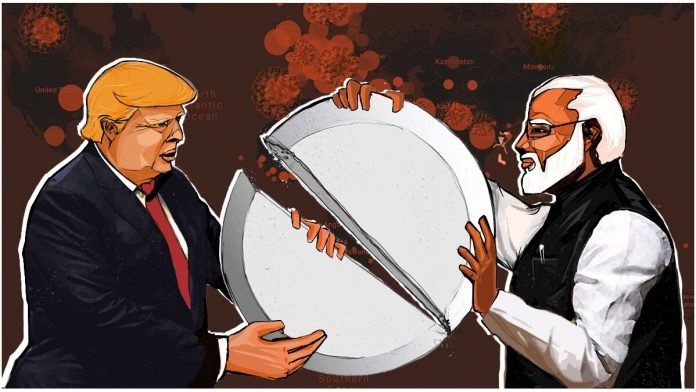India as a Pharmaceutical Power of the world

The COVID 19 outbreak has put pressure on the pharmaceutical markets of the world. North America, Europe and Japan jointly account for 82% of audited and unaudited drug sales. Annual growth in the European Union (EU) has slowed to 5.8%, and sales are increasing at an even more sluggish rate in Japan (2.1%) and North America (1.4%). Impending policy changes, promoting the use of generics in these key markets are expected to further dent the top- and bottom-line of global pharma majors. The industry is bracing itself for some fundamental changes in the marketplace and is looking at newer ways to derive growth. The growing Indian pharmaceutical market is likely to become a competitor & a potential partner. The exponential rise in the cases of COVID 19 and subsequent deaths has put an unsurmountable pressure not only on the frontline & essential service workers but also the medicine industry. With no respite from the pandemic, the world leaders and industries are looking up to India to help them provide medicines like Hydroxychloroquine & Azithromycin supplies. India has considerable manufacturing expertise and Indian companies are among the world leaders in the production of generics and vaccines. As both of these areas become more important, Indian producers are likely to take a large role on the world stage – and potentially partner with global pharma companies to market their wares outside of India.
India’s pharmaceuticals industry looks set for solid long-term growth. It already ranks fourteenth in the global league table. The Indian Government’s Department of Pharmaceuticals has also initiated operations for a peoples’ medicines shop, called ‘Jan Aushadhi,’ in various locations. These shops sell generic medicines at much cheaper rates than the price of corresponding branded medicines. Some multinational pharma companies are already taking measures to reach a larger patient population by reducing drug prices and increasing affordability. As part of the Commonwealth, India inherited its intellectual property laws from Great Britain. However, after gaining independence in 1947, there was a growing consensus that to boost manufacturing restrictive product patents must be temporarily removed. In 1970, amendments to the Indian Patents Act abolished product patents but retained Process patents with a reduced span of protection.
During the absence of any product patent regime, the Indian Pharmaceutical Industry grew at a remarkable pace, ultimately becoming a net exporter, the world’s third-largest by volume, and fourteenth-largest by value. The Novartis Vs. Union of India is a landmark decision by a two-judge bench of the Indian Supreme Court on the issue of whether Novartis could patent Gleevec in India. Supreme Court decided that the substance that Novartis sought to the patent was indeed a modification of a known drug (the raw form of imatinib, which was publicly disclosed in the 1993 patent application and in scientific articles), that Novartis did not present evidence of a difference in therapeutic efficacy between the final form of Gleevec and the raw form of imatinib, and that therefore the patent application was properly rejected by the patent office and lower courts. Had Novartis won and gotten its patent issued, it could not have prevented generics companies in India from continuing to sell generic Gleevec, but it could have obligated them to pay a reasonable royalty under a grandfather clause included in India’s patent law.
India is looking at a setting up an indigenous base for manufacturing Active Pharmaceutical Ingredients (API) as the Indian Pharmaceutical industry aspires to become the world’s largest supplier of drugs by 2030. India aims to increase its industry revenue to $120 billion-$130 billion by 2030 from current revenue of $38 billion at a compound annual growth rate (CAGR) of 11-12%. Pharmaceuticals are a major component of India’s trade expansion strategy, particularly with the country’s stated objective of diversification of exports in terms of both products as well as destinations. The COVID-19 global pandemic has brought to the fore the intricate interdependencies that exist within the international pharmaceutical market. China, the epicentre of the global outbreak, is also the world’s largest supplier of active pharmaceutical ingredients (APIs), also known as bulk drugs. India, which is a leading exporter of generic drugs across the world, depends on China for more than two-thirds of its bulk drug needs. Estimates indicate that India supplies up to 50% of the United States’ generic drug needs and vulnerabilities caused by COVID-19 have caused disruptions across global pharmaceutical supply chains. Perhaps this is also a good opportunity for India to reassess dependencies and plan for the future. India’s need to produce its own bulk drugs can perfectly align with its ambition to become a bulk drug exporter to markets like Africa. Given this context, India should consider embracing economies of scale and increasing the production of bulk drugs to aggressively compete with the Chinese in the Africa market. Also, with the ongoing trade war with the US, China has offered a major push to its pharmaceutical sector to diversify and produce generics and biosimilars. This move to aggressively replace innovation drugs with homemade follow-on drugs may have an implication for export markets like Africa as well.

In view of the humanitarian aspects of the pandemic, India has decided to license paracetamol and Hydroxychloroquine (HCQ) in appropriate quantities to all its neighbouring countries who are dependent on its capabilities. It will also be supplying these essential drugs to some nations that have been particularly badly affected by the pandemic. India is a leading global player in the manufacturing of HCQ with Ipca Laboratories, Zydus Cadila, Wallace Pharmaceuticals and Cipla as top pharma companies. A derivative of chloroquine, HCQ has fewer side-effects. This has upped medical diplomacy and made India the shining star in tackling the pandemic with grace and helping the others by giving a helping hand, yet again proving that the world indeed is one family.
India has been a cradle of human civilization and throughout its glorious history, has helped nations secure their citizens’ welfare. This will remain the same post the COVID 19 crisis with only the world recognizing the same and hopefully helping India secure its place in the comity of nations.


 |
|

















